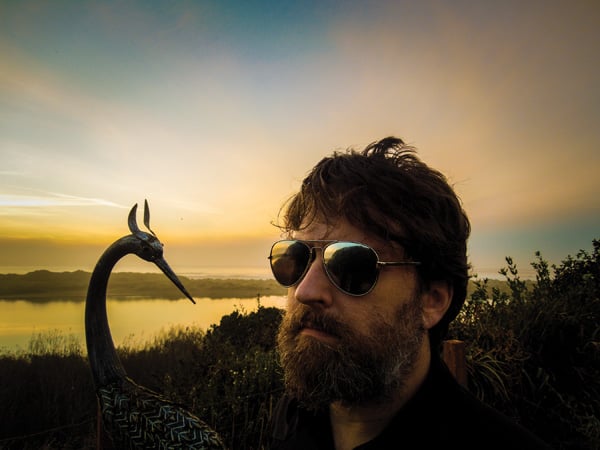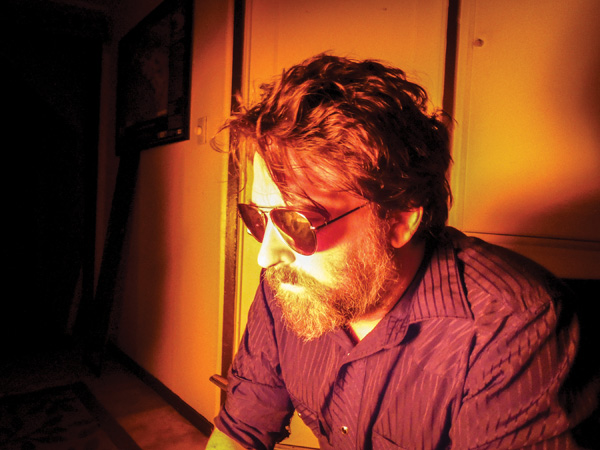Ben Chasny’s New Composition Method Could Be a Game-Changer
Beginning as a solo endeavor for Ben Chasny, Six Organs of Admittance now regularly features other musicians in concert and as guests on records. Original inspiration for the band came from wanting to merge the styles of fingerpicked acoustic guitar with more improvisational elements. Their sound has moved toward electric, psychedelic, and folk styles throughout the years. The newest Six Organs of Admittance record, Hexadic, is to be released this month on Drag City. The particular songs on this record were bent toward the idea of rock music. While every album is different in their own special way, Hexadic is truly unique.
“I wanted to create new paths for guitar playing, paths that turn away from ‘normal’ tonality. In a way I suppose it is a bit anarchic because I wanted to ignore structure and think of playing in terms of individual tones and the way they can be combined and recombined. I guess you could call it a re-territorialization of the fretboard. It has precedents in modern composition, of course, but I wanted to think purely in terms of guitar. I don’t think many people will care much about this, but I do, so I did it.”
Hexadic is the result of years of working on a new way to compose music. The process is malleable, and in a sense, is an open system; Chasny explains that this system “exists as an aleatory, combinatorial and meditative practice.” It is pragmatic in the sense that it can help with the memorization of notes, and at the same time, it is surreal in the sense that “the method of teasing out songs from a framework is not entirely different than Ernst’s use of decalcomania.”
When it comes to the songwriting process, Chasny tries not to limit himself. Some songs take years to create, while others have been written and recorded in hours and are then used on records. However, with Hexadic, he created a system of composition based on chance and combinatorial methods that begins by building a basic framework for each piece before he engages with it. From the basic framework, he teases out tonal relationships and word structures. Everything is a little different with this album; in the past he would write the melody first, but this new method makes the words dependent on the music, but not in terms of melody. “Melody arises in the performance only because the music in improvised.” In fact, all of the words on the record were written using the language aspect of the system.
The system itself consists of different aspects that can interact with each other or exist on their own. There are game, graphic, and language aspects that intersect with the plane of tonal relationships in a way that creates a unique assemblage. Since the system uses a deck of playing cards as the ‘ur-ground’ that most of the aspects of the system are born from, Drag City and Chasny have created a special Six Organs deck of playing cards.
“The cards have special markings to help with aspects of the system. For instance, there are markings to signify specific cards that are used to create a pattern that is used for composition.” To expand upon this idea, spades have plus and minus signs on them to identify them as cards to be used for alternate tunings or as ‘intensity’ signifiers for tonal fields. The face cards in the deck depict individuals who Chasny admires or who have influenced Six Organs. You’ll find Gaston Bachelard as the king of hearts, Octavio Paz as the king of spades, and Maya Deren as the queen of hearts. Creating the cards was a “nice excuse to do something fun and creative in the visual realm.” The cards are an ordinary deck of playing cards, a crucial tool that’s part of the system, but they utilize “the system to get out of a creative jam.”
There is no such thing as an average recording session; it all depends on what the record hopes to sound like. “After 15 years of recording with this project, which is essentially just me, you can imagine that many scenarios have arisen.” Every record is different with different people, engineers and tones. In the studio, an engineer accompanies Chasny but when recording at home, majority of time he is flying solo. “I can’t say there is a typical situation. That’s one of the things that keeps me doing it. New situations.”
Using this new composition system, Chasny composed thirty pieces but only used nine for Hexadic. Chasny doesn’t consider the twenty-one compositions he didn’t use on the album as ‘songs’ – they can be better classified at “pre-compositions, because they are merely the frameworks for future songs. I would consider them ‘songs’ once the individual tonalities have been established.” These pre-compositions live on paper, as charts, and as various letters that can be built into words. “Right now, they are merely possibilities.” Chasny chose the ones that were used on the album because they made for a more rock-oriented record. Chasny notes, “If the system gave me a pre-composition that had fifteen tonal fields in a progression, I disregarded that because I wanted to make something immediate. I kept the pieces that had few tonal fields.” Few tonal fields make rock n’ roll.
This new composition process that Chasny has generated led to the creation of Six Organs’ first true rock record. The album also features Noel Von Harmonson (Comets, Sic Alps, Heron Oblivion), Rob Fisk (Common Eider, King Eider, Badgerlore, ex-Deerhoof) and Charlie Saufley (Assemble Head in Sunburst Sound, Meg Baird, Heron Oblivion).
Chasny still has those twenty-one pre-compositions on paper, waiting to be teased out into full songs in the future. “I have them filed away. Anything is possible.”
Follow on Twitter @6organs
photos by Stockton


